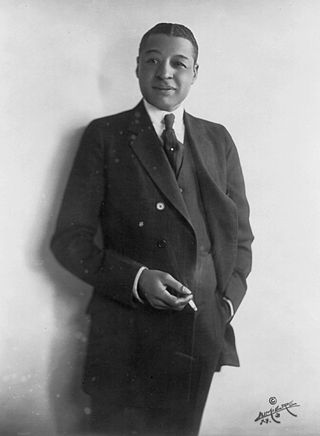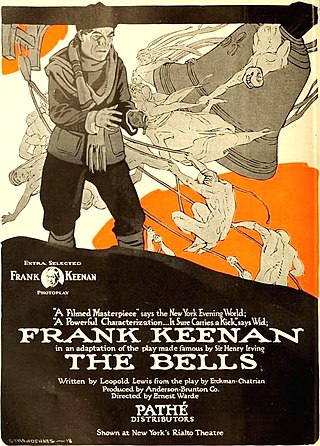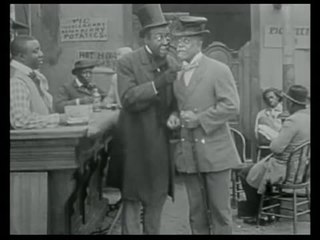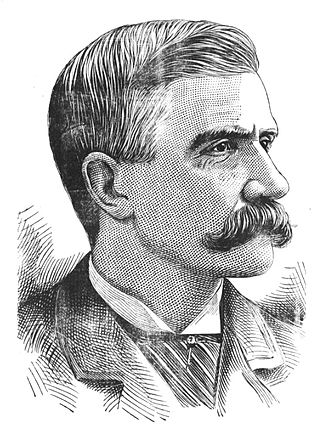
Bert Williams was a Bahamian-born American entertainer, one of the pre-eminent entertainers of the vaudeville era and one of the most popular comedians for all audiences of his time. While some sources have credited him as being the first Black man to have a leading role in a film with Darktown Jubilee in 1914, other sources have credited actor Sam Lucas with this same distinction for a different 1914 film, the World Film Company's Uncle Tom's Cabin. Ebony stated that "Darktown Follies was the first attempt of an independent film company to star a black actor in a movie", and credited the work as beginning a period in independent American cinema that explored "black themes" within works made for African-American audiences by independent producers.

The Biograph Company, also known as the American Mutoscope and Biograph Company, was a motion picture company founded in 1895 and active until 1916. It was the first company in the United States devoted entirely to film production and exhibition, and for two decades was one of the most prolific, releasing over 3000 short films and 12 feature films. During the height of silent film as a medium, Biograph was the most prominent U.S. film studio and one of the most respected and influential studios worldwide, only rivaled by Germany's UFA, Sweden's Svensk Filmindustri and France's Pathé. The company was home to pioneering director D. W. Griffith and such actors as Mary Pickford, Lillian Gish, and Lionel Barrymore.

Abriea "Abbie" Mitchell Cook, also billed as Abbey Mitchell, was an American soprano opera singer. She performed the role of Clara in the premiere production of George Gershwin's Porgy and Bess in 1935, and was also the first to record "Summertime" from that musical.

Actuality film is a non-fiction film genre that uses footage of real events, places, and things, a predecessor to documentary film. Unlike documentaries, actuality films are not structured into a larger narrative or coherent whole. During the era of early cinema, actualities—usually lasting no more than a minute or two and usually assembled together into a program by an exhibitor—were just as popular and prominent as their fictional counterparts. The line between "fact" and "fiction" was not as prominent in early cinema as it would become once documentaries became the predominant non-fiction filmmaking form. Actuality as a film genre is related to still photography.

In Dahomey: A Negro Musical Comedy is a landmark 1903 American musical comedy described by theatre historian Gerald Bordman as "the first full-length musical written and played by blacks to be performed at a major Broadway house." It features music by Will Marion Cook, book by Jesse A. Shipp, and lyrics by poet Paul Laurence Dunbar. It was written by Jesse A. Shipp as a satire on the American Colonization Society's back-to-Africa movement of the earlier nineteenth century.

Sam Lucas was an American actor, comedian, singer and songwriter. His birth year has also been reported as 1839, 1841, 1848 and 1850.

African-American musical theater includes late 19th- and early 20th-century musical theater productions by African Americans in New York City and Chicago. Actors from troupes such as the Lafayette Players also crossed over into film. The Pekin Theatre in Chicago was a popular and influential venue.
The 49th National Society of Film Critics Awards, given on 3 January 2015, honored the best in film for 2014.

An Unseen Enemy is a 1912 Biograph Company short silent film directed by D. W. Griffith, and was the first film to be made starring the actresses Lillian Gish and Dorothy Gish. A critic of the time stated that "the Gish sisters gave charming performances in this one-reel film". The film was shot in Fort Lee, New Jersey where early film studios in America's first motion picture industry were based at the beginning of the 20th century. Consistent with practice at that time, the actors in the cast and their roles are not listed in the film..

The House with Closed Shutters is a 1910 American silent drama film directed by D. W. Griffith and released by the Biograph Company. Prints of The House with Closed Shutters exist in the film archives of the Museum of Modern Art, George Eastman House, and the Library of Congress.

Thomas Hayes Hunter was an American film director and producer of the silent era. He directed a total of 34 films between 1912 and 1934.

The Bells is a lost 1918 American silent drama film released by Pathé Exchange. It was adapted from the 1867 French play Le Juif Polonais by Erckmann-Chatrian and an 1871 English-language version, The Bells, by Leopold Lewis. The latter was a favorite vehicle for actor Henry Irving. This silent film stars Frank Keenan and Lois Wilson. The story was remade in 1926 as The Bells with Lionel Barrymore and Boris Karloff.

A Natural Born Gambler is a 1916 silent film short, the first of only two films starring Broadway comic and singer Bert Williams. The film was Williams' first two-reel comedy, and was a film that was expected not to disappoint audiences and was highly anticipated. It was produced by the Biograph Company and released by The General Film Company. Williams directed and G. W. Bitzer, also known as Billy Bitzer, who was usually D. W. Griffith's cameraman, was the cinematographer. This is a still-surviving film, featuring Williams in his famous blackface routine. It is an authentic comedic film for its time (1916) in which Williams is still humorous without heavily relying on the popular physical style of slapstick comedy. Special and strategic advertising along with the name Williams had created for himself made it possible for the film to get exposure throughout the country. Most of this exposure came from newspaper prints.

A Wreath in Time is a 1909 American silent comedy film written and directed by D. W. Griffith, produced by the Biograph Company of New York City, and co-starring Mack Sennett and Florence Lawrence. At its release in February 1909, the short was distributed to theaters on a "split reel", which was a single reel that accommodated more than one film. A Wreath in Time shared its reel with another Biograph short also directed by Griffith, the drama Edgar Allen Poe [sic]. Original paper rolls of contact prints of both motion pictures, as well as safety-stock copies of the two films, are preserved in the Library of Congress.

Lime Kiln Field Day is a 1913 American black-and-white silent film produced by the Biograph Company and Klaw and Erlanger. Unnamed, unassembled, and abandoned by its producers during post-production, the original footage was saved when Biograph donated its vaults to the Museum of Modern Art in 1938. It is considered to be the oldest surviving feature film with an all-Black cast.
Odessa Warren Grey was milliner, entrepreneur, and performer in Harlem, New York. She is best known as the star of the silent film, Lime Kiln Field Day (1913) where she co-stars with Bert Williams.

Charles Bertrand Lewis, better known by the pen name M. Quad, was an American journalist and humorist.

V. Floyd Campbell was an American illustrator and caricaturist.
Wes Jenkins (1859-1930) was an American actor active during Hollywood's silent era. He appears in an untitled Biograph film from 1913 that has been dubbed Lime Kiln Field Day; held by MoMA, the seven-reel clip is thought to be the oldest surviving footage of black actors.

A Sound Sleeper is a 1909 American comedy film directed by D. W. Griffith and produced by the American Mutoscope and Biograph Company. The short was filmed in one day in the Coytesville borough of Fort Lee, New Jersey, which at the time was a popular filming location for many early motion-picture studios in the northeastern United States. Due to the brief running time of this comedy, it was originally distributed in April 1909 on a split reel with another Biograph release, a longer dramatic film titled The Winning Coat.